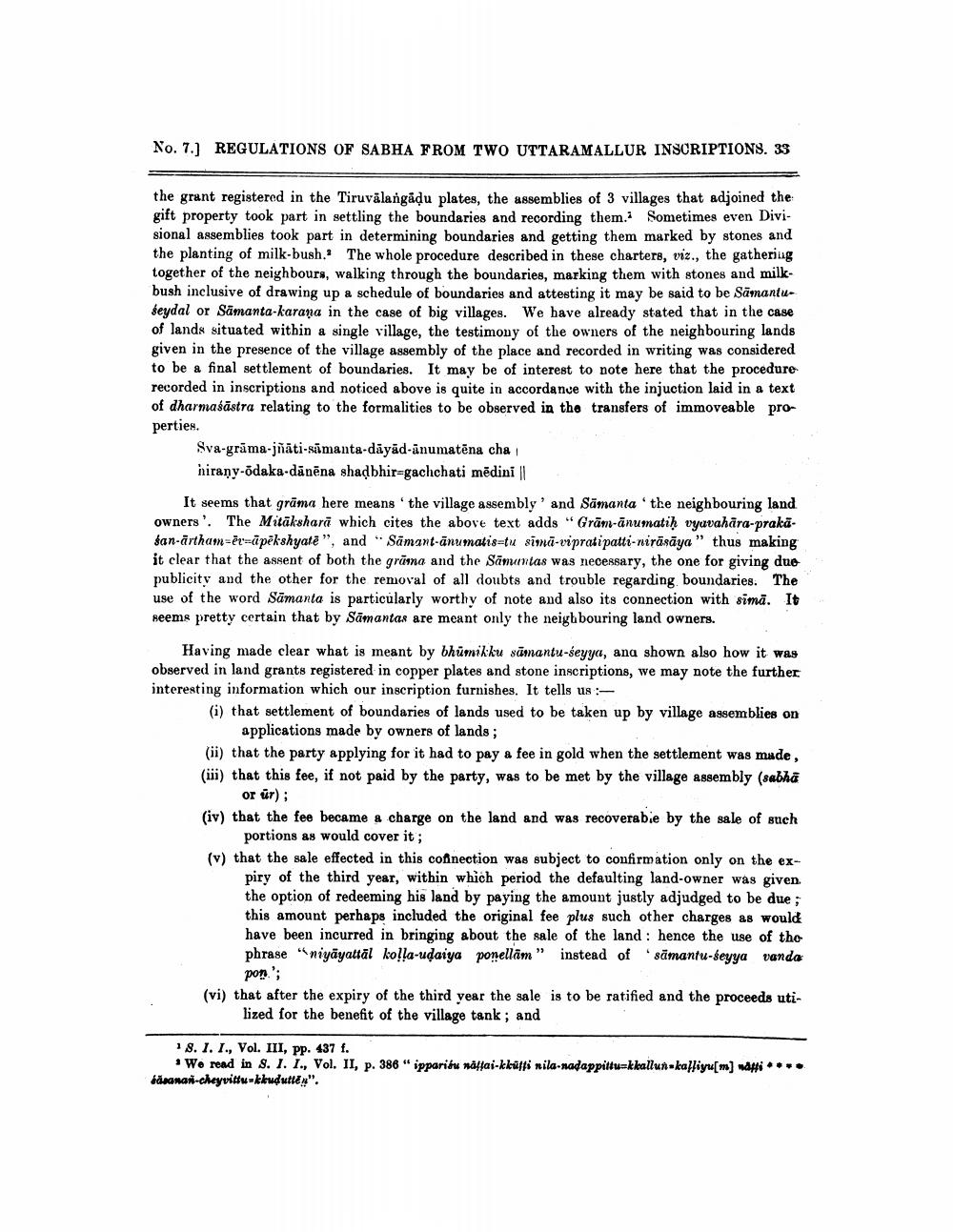________________
No. 7.) REGULATIONS OF SABHA FROM TWO UTTARAMALLUR INSCRIPTIONS. 33
the grant registered in the Tiruvälangadu plates, the assemblies of 3 villages that adjoined the gift property took part in settling the boundaries and recording them. Sometimes even Divisional assemblies took part in determining boundaries and getting them marked by stones and the planting of milk-bush. The whole procedure described in these charters, viz., the gathering together of the neighbours, walking through the boundaries, marking them with stones and milk. bush inclusive of drawing up a schedule of boundaries and attesting it may be said to be Samantuseydal or Sämanta-karana in the case of big villages. We have already stated that in the case of lands situated within a single village, the testimony of the owners of the neighbouring lands given in the presence of the village assembly of the place and recorded in writing was considered to be a final settlement of boundaries. It may be of interest to note here that the procedure recorded in inscriptions and noticed above is quite in accordance with the injuction laid in a text of dharmaśāstra relating to the formalities to be observed in the transfers of immoveable properties.
Sva-grama-jñati-samanta-dāyād-anumatēna cha
nirany-õdaka-dānēna shadbhir=gachchati mēdini |
It seems that grāma here means 'the village assembly and Sämanta 'the neighbouring land owners'. The Mitāksharā which cites the above text adds “Grām-ānumatih vyuvahāra-prakā. san-artham=ēr=apēkshyate", and "Sānant-ānumatis=tu simā-vipratipatti-nirāsāya " thus making it clear that the assent of both the grāma and the Sāmuntas was necessary, the one for giving due publicity and the other for the removal of all doubts and trouble regarding boundaries. The use of the word Sämanta is particularly worthy of note and also its connection with simā. It seems pretty certain that by Samantar are meant only the neighbouring land owners.
Having made clear what is meant by bhumikku samantu-seyya, ana shown also how it was observed in land grants registered in copper plates and stone inscriptions, we may note the further interesting information which our inscription furnishes. It tells us :
(i) that settlement of boundaries of lands used to be taken up by village assemblies on
applications made by owners of lands; (ii) that the party applying for it had to pay a fee in gold when the settlement was made, (iii) that this fee, if not paid by the party, was to be met by the village assembly (sabha
or ür); (iv) that the fee became a charge on the land and was recoverable by the sale of such
portions as would cover it; (v) that the sale effected in this connection was subject to confirmation only on the ex
piry of the third year, within which period the defaulting land-owner was given the option of redeeming his land by paying the amount justly adjudged to be due ; this amount perhaps included the original fee plus such other charges as would have been incurred in bringing about the sale of the land: hence the use of the phrase "niyāyattal kolla-udaiya ponellām" instead of "sämantu-seyya vanda
pon. '; (vi) that after the expiry of the third year the sale is to be ratified and the proceeds uti
lized for the benefit of the village tank; and
18. 1. I., Vol. III, pp. 437 f.
• We read in 8. 1. I., Vol. II, p. 386 Wipparibu naffai-kküffi nila-nadappittu=kkallun-kafliyu[m] di *** daanan-cheyvittu-kluduttan".




